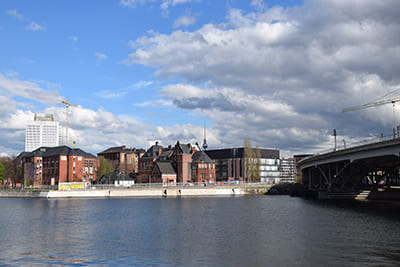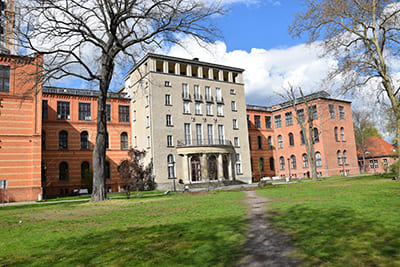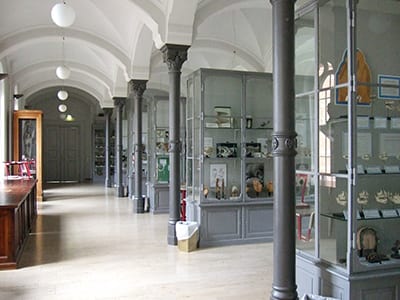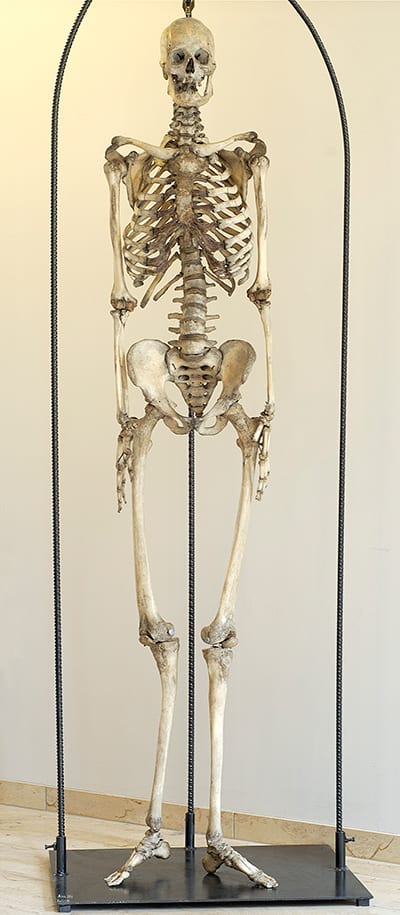After a short summer and scarcely a moment to enjoy the arrival of fall, the cold winter season has again arrived in Berlin. It’s so chilly outside
that I started looking around for indoor activities.Berlin is full of museums, so there’s plenty to experience inside. But this time, I want to introduce a place that is a bit more hidden.It belongs to the city’s most famous hospital, Charité. The hospital was originally built outside the city in 1710 as an isolation hospital for patients with the plague. As Berlin grew, however, its edges pushed beyond and the hospital is now located in the heart of the city.In 1727, the Charité became a military hospital that already trained physicians. Then, exactly 100 years after its foundation, a university with a medical college was built.The hospital has some modern buildings like the high-rising ward building, but most distinctive are Charité’s red brick buildings that were constructed between 1896 and 1917.

The view of Charité from Berlin Central Station
Charité also has a museum exhibition with more than a hundred years of history. It was established in 1899 by Rudolf Virchow, famous for having discovered leukemia. By 1901, the number of preparations in the museum collection had already reached 23,066 and it was also already open to the general public up until 1914.Out of the 35,000 preparations that had been collected until World War II, just 1,800 remained after the war had ceased. The facility was just reopened as a Museum of Medical History in 1998.In addition to medical history and a history of the Charité, the museum allows visitors to see a variety of preparations. If you tend to be a bit squeamish though, you might have to prepare yourself before you go see the anatomical collection.Part of the collection can also be viewed outside the museum at Waldeyer Haus, where the anatomical collection of Charité and the university is located.

Outside view of Waldeyer House
Anybody is free to visit and see a part of this collection. The exhibits are ordered by subject areas and there is a short explanation offered. As there is quite complex anatomical reference samples to see, there are tables and 80 seats ordered around the showcases, which allows students to study there on them own.
View on the collection. With very few visitors it was completely quiet. Source:Charité – Universitätsmedizin Berlin
The building itself is named after Wilhelm Waldeyer, who served as head of the anatomy department until 1917. The part of the collection that is seen quite as controversial was amassed during Waldeyer’s time. Problematic are skeletons and skulls collected from all over the world during the colonial period. In addition these had been used in pseudo-anthropological research, used to advance the racist doctrine of the time.The group or specimens in question were studied over three years under the Charité Human Remains Project. One purpose of this project was to return the remains and other seized items to their original countries, for instance Namibia. One example for this controversial specimens is for sure the Peruvian mummy, exhibited in the collection.Project activities were based on the Leiden Declaration on Human Anatomy /Anatomical Collections, which is an international declaration stipulating the treatment of human remains.The main reason I went to see the collection for, was to take a look on the bones of the Langer Kerl(“long guy”). Langer Kerl was a colloquial expression used to refer to the imperial guards that served under the Prussian king Frederick William I. Also known as the Potsdam Giants, the infantry only accepted men taller than 1.88 meters in height.
This skeletton is thought to be a Langer Kerl that died in 1880 only 28 year old. The skeleton is 2.23m high. In Waldeyer Haus it is of course not exhibited like this, but is shown in a showcase. Source:Charité – Universitätsmedizin Berlin
You can of course get more information in the Museum of Medical History, but the collection at Waldeyer Haus offers a unique atmosphere that allows you to spend some time on you own. Of course you also have to pay attention, when there are students learning, and move around quietly.To conclude I would like to thank the person in charge in Charité for the provided photos of the collection.


































































